Combat aircraft. Herald of great problems
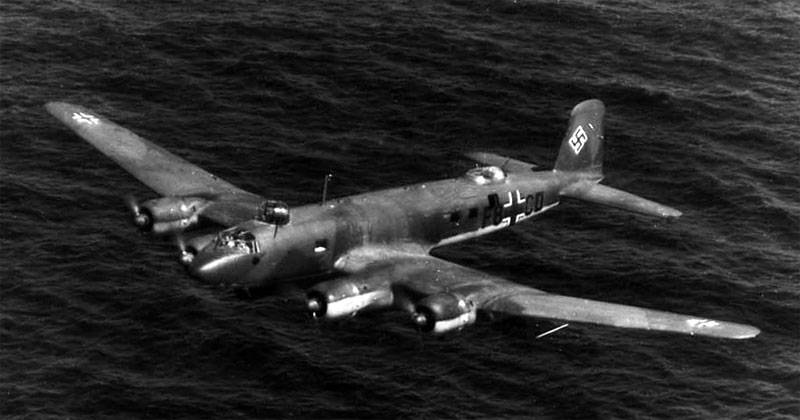
Perhaps not much in stories That war there were such aircraft, the least suitable for the role of combat, but, nevertheless, plowed the whole war. Perhaps, Polikarpovsky Po-2 is beyond competition here, but our hero is from a different weight category.
And the question "Who are you?" very hot for him. For wherever they did not write down the experts of the "Condor", and in transport, and torpedo bombers, and long-range naval reconnaissance ... And everything is completely fair. Due to the fact that the Germans had a huge shortage of long-range aircraft, they did not try on the Fw.200 as soon as they tried to use it!
It cannot be said that the Fw.200 was very noticeable on the fronts. Only 276 cars were produced, which, of course, played a role in the war, but how significant it was is the question.
"Condor" was born in the "Focke-Wulf" collective under the leadership of Kurt Tank very calm and unhurried, like a transatlantic passenger liner. And as a result, he was born in 1937. And in 1938 he already very loudly declared himself, having flown from Berlin to New York in 24 hours and 56 minutes. No landing. And he returned in 19 hours 55 minutes. And also without intermediate landings.
Then there were no less spectacular flights Berlin - Hanoi and Berlin - Tokyo. They started talking about the plane, "Focke-Wulf" began to receive orders for the Fw.200 from the world's airlines.
As a passenger liner, the Condor was luxurious. 26 passengers flew in very good conditions. The plane had a kitchen on board, an air conditioning system, passengers had separate folding tables, reading lamps, a radio and many other useful things.
The Condor proved to be a very reliable aircraft, so it is not surprising that one of the Fw.200s became the # 1 aircraft of the Third Reich.
At the same time, as was then customary in Germany, a military vehicle was being worked on with the passenger version. This version of the Fw.200 was distinguished primarily by a large ventral gondola, which housed two firing points, front and rear. Between the machine-gun mounts, in the middle of the gondola, there were bomb bay doors.
The dimensions of the bomb compartment, frankly, were small, because the maximum that an aircraft could take was 1000 kg of bombs. Four SG.250 bombs. A solution was found in placing bombs on an external sling, which, together with the gondola, greatly worsened the aerodynamics of the aircraft. Under the nacelles of the external engines, one SC 250 bomb could be suspended, and on two ETC 250 holders, located at the junction of the wings with the fuselage, one more.
I had to change the engines. The maximum that the German industry could offer was a BMW-132 with a capacity of 850 hp, so the maximum speed of a military aircraft was deprived of 360 km / h.
In addition to two machine-gun points in the gondola (rear - C-Stand and front - D-Stand), two more machine-gun points were placed on the ridge of the fuselage, A-Stand immediately behind the cockpit and the second in the rear - B-Stand.
In the side windows of the tail section, they mounted stops for MG.15 machine guns (on the right side of the E-Stand, and on the left side of the F-Stand), from which, if necessary, the radio operator had to shoot.
This model was named Fw.200C and went into production. The aircraft of the first modification were tested for the use of torpedoes, but the results were very low. The hefty four-engined vehicle lacked the maneuverability to accurately target.
With the second modification of the Fw.200C-2, the appearance of the aircraft was finally formed. The external ETC bomb racks were replaced with PVC, which increased the bomb load by 900 kg. The course 7,92-mm machine gun in the ventral gondola was replaced by a 20-mm MG-FF cannon.
In this form, the plane went to the flight reconnaissance units and began military service.
The Condors were baptized by fire in April 1940 during the operation to capture Norway. Aircraft from 1./KG 40, operating from airfields in Denmark, on April 15 found in Narvik a convoy of a cruiser, a destroyer, 5 auxiliary vessels and 16 transports.
On April 21, the first successful combat use of the Fw.200 took place. A group of three Condors bombed the aircraft carrier Furious, which was defended in a fiord north of Tromsø. One of the bombs fell near the ship and the explosion damaged the propeller of the aircraft carrier, forcing it to leave for repairs.
In total, four Condors were lost during the operation in Norway. Successes as strike aircraft were, frankly, more than modest, the landing ship was damaged by bombs, the crew of which and the entire landing were captured.
An attempt was made to use the FW.200 as a mine master. At that time, the Germans were using two main types of mines, the LMB weighing 630 kg and the LMA weighing 1000 kg. The FW.200 could carry 4 LMB mines on the external suspension. More than 1940 sorties were carried out in July 50 for laying mines, which cost the Luftwaffe 2 downed aircraft. Despite the fact that mine laying was carried out at night, the RAF was able to intercept the Condors, which lost about 100 km / h speed when the mines were suspended on external holders.
It was decided to stop such use of the "Condors" and focus on reconnaissance flights.
In general, it was implemented in a very original way. All planes involved in the mine laying were transferred to Bordeaux, from where they began their flights over British territory and sea areas. They landed at airfields in Denmark, underwent maintenance and after a while flew back to Bordeaux. One such flight is from 3500 to 4000 kilometers.
Also "Condors" patrolled the territories in the Azores and in the Atlantic abeam Portugal.
During such flights, the Kriegsmarine quickly figured out how to arrange the detection of British convoys and the guidance of submarines at them. Considering the simply excellent German radio systems, as well as the rather quick response to information, things started to work out.
But apart from reconnaissance flights, the Condors easily coped with such things as successful attacks of single transports. Over time, the crews began to impute attacks on single ships, since at the beginning of the war the transports were not protected in terms of anti-aircraft weapons at all.
So the slow-moving and clumsy transports were very, very good targets for the Condors, despite the fact that the FW.200 was not itself fast and maneuverable.
In the three months of autumn 1940, the FW.200 attacked 43 ships, successfully sinking 9 with a total displacement of 44 tons and damaging 066 more.
The low speed of the Condors played a role here, as it provided very accurate aiming. And, of course, the lack of air defense on transports.
The first victim of the Condor was the British steamer W. Goathland "with a displacement of 3 821 tons, which was sunk on August 25, 1940.
The first sunk ship was followed by others, but on October 26 of the same year, FW.200 under the command of Bernhard Jope, during the first sortie, discovered and attacked one of the largest British liners, turned into a transport for transporting troops. It was the "Empress of Britain" with a displacement of 42 gross tons.
Two more than accurately dropped bombs set off a fire aboard the ship. However, the liner snapped, fortunately, some anti-aircraft weapons were installed on it. "Condor" got into one of the engines and Jope decided not to make a second call, preferring to go to base on three engines.
The crew of the liner coped with the fire, but the liner lost full speed and was eventually discovered and finished off by the U 32 submarine. The Empress of Britain became the largest ship in displacement that the Germans sank during World War II.
So the FW.200, despite the fact that the bomb load was small, made up for it with accuracy and showed quite decent success.
The tactics used by the German pilots were simple: the plane entered from the stern, descending to an altitude of 50-100 meters at a speed of about 300 km / h. The shooters tried to neutralize the air defense calculations on the ship, and at the time of the flight, one or two bombs were dropped. For a ship with a displacement of up to 5 tons, a single bomb hit of 000 kg could be fatal. And for small vessels it was quite enough to receive a burst from a course 250-mm gun.
The modification of the FW.200C-3 deserves separate consideration. This model was equipped with significantly more powerful engines BMW 323R-2 "Fafnir", 1000 hp. at sea level, and 1200 hp. at an altitude of 3200 m.
This change did not affect the speed in any way, since the power of the engines went to other purposes. The first pilot and gunners in places B, C and D received armor with 8-mm plates against anti-aircraft fire from ships.
The bomb load dropped to 2100 kg (12 bombs of 50 kg each or 2 bombs of 250 kg in the bomb bay plus 4 bombs of 250 kg each on the external hardpoints), but the Condors usually went on patrol and reconnaissance missions with a maximum supply of fuel and four bombs 250 kg each.
The configuration of the radio equipment was significantly changed, in which the shortwave radio station DLH-Lorenz-Kurzwellenstation, the Peil GV radio receiver, the equipment for landing without land visibility Fu.Bl.l and the equipment for identifying "friend or foe" FuG 25 were added.
Instead of the A-Stand firing point behind the cockpit, a rotating FW-19 turret was installed with the same MG.15 machine gun with an ammunition capacity of 1125 rounds.
After the introduction of all these changes, the total weight of the aircraft increased to 20 834 kg, but the speed and other indicators remained the same.
Of course, the British were not at all happy with this. Especially the fact that according to the intelligence of the "Condors" submarines were directed to the convoys. And since all this was happening outside the range of British coastal radars, plus the Luftwaffe guarded the Condor base in Bordeaux Merinac well, punishing the British bombers who tried to bomb the base, then the matter came to a standstill.
So the most that the British did was move three battalions of long-range fighters based on the Blenheims closer to the Condor's area of operations. So-so a measure, because "Blenheim" fighters flew at a slightly higher speed than "Condors". That is why they did not always have a chance to catch up with the FW.200, which, of course, did not want to fight, preferring to hide.
We tried to fight the Condors with the help of trap ships, like with submarines in the First World War. They took a transport, "Crispin", installed ten 20-mm "Oerlikons" on it and sent them to patrol the area where the Germans usually behaved. The idea to portray a single transport was good, but the British hunter did not manage to catch at least one Condor in the net, because he was torpedoed by the German submarine U.107, ironically directed by the Condor, which had no bombs left ...
There was even a plan to land a group of commandos on a captured Danish Condor at the Bordeaux-Merinac airfield. The paratroopers had to try to destroy as many FW.200s as possible. The plan was not implemented, but showed how useful the work of the Condors in the Atlantic was.
In early December 1940, the Pegasus seaplane transport ship armed with a catapult and three Fulmar fighters was sent to the Iceland region as additional protection against the Kondors.
The Pegasus was supposed to cover the convoys, but ...
On January 11, 1941, the Condor impudently attacked the HG-49 convoy. Yes, Fulmar was launched from Pegasus, but while preparations and launch were underway, the Condor sank the steamship Veasbu (1600 gross tons) and calmly went into the clouds.
In total, in 1940, the crews of KG 40 sank 15 vessels with a displacement of 74543 gross tons and damaged 18 more, with a total displacement of 179 gross tons. Own losses amounted to 873 aircraft.
More than significant. And in January (16th) 1941, the already mentioned Chief Lieutenant Jope set a kind of record: in one sortie he sank 2 ships from the OV 274 convoy: the Greek steamer Meandros (4 gross tons) and the Dutch tanker Onoba (581 6 gross tons).
And in just the first two months of 1941, KG.40 sank 37 ships with a total displacement of 147 gross tons, losing 690 aircraft.
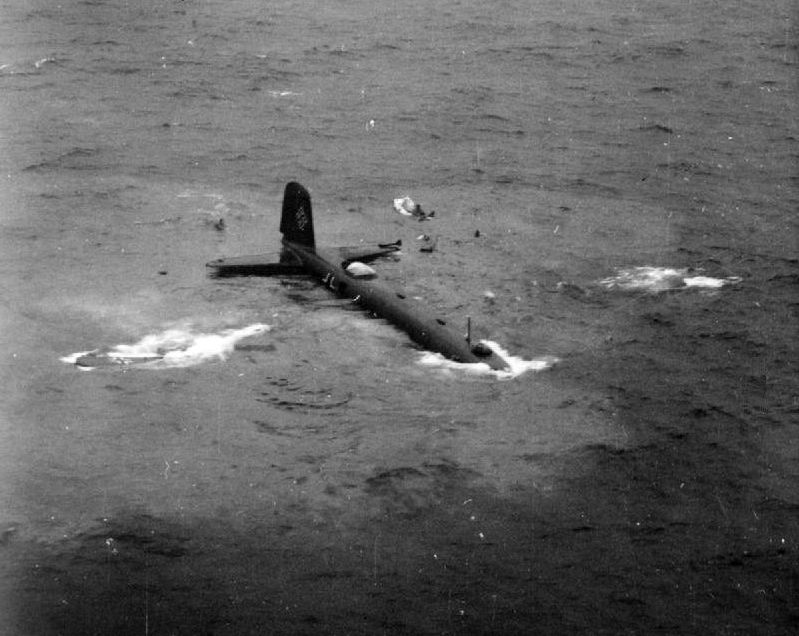
In general, I would say that the Kondor crews were staffed with professional thugs who did not shy away from anything. Even air combat, which I already wrote about.
Historical detective. When nowhere to go, or Clash of the Titans over the sea.
A very demonstrative fight, by the way. That is the case when both sides were approximately equally reckless and courageous, it was just that the Americans were courageous a little longer and deservedly won.
But later, as all the transport ships were re-armed with automatic cannons, the losses of the Condors continued to grow, and as a result, the command stopped shock flights and concentrated the efforts of the crews on the search and detection of convoys, followed by guidance on the submarine ships.
Thanks to the increased supply of new aircraft, the I./KG 40 was able to simultaneously send up to eight Condors into the skies over the Atlantic. Considering the area covered by the reconnaissance flights, this was very good. Especially compared to the two planes a day sent over the Atlantic in the first half of 1941, it can be said that this was a giant step forward.
Plus, cooperation with the Abwehr was strengthened, whose agents regularly reported on the departure of the next convoy from the same Gibraltar.
In August 1941, the Condors, operating from Bordeaux, tried to attack targets in the Suez Canal. There were no results, except for the loss of three aircraft, the British were already well trained by the Condor crews, and therefore defended their ships more and more seriously.
In response to the Focke-Wulf, another modification was born, the main essence of which was to further stuff in terms of radio equipment in the range (FuG.X, Peil GV, FuBl.1, FuG.27, FuG.25 and FuNG.181), installations instead of shooting point A at the top of the fuselage turret HD.151 circular rotation with a cannon MG.151 caliber 15 mm with a stock of 1000 rounds and a new bombsight type Lotfe 7H, with which it was possible to aim bombardment from a height of 3000 meters.
By the way, it was on the basis of the FW.200C-3 that the FW.200C-4 / U1 modifications were made for Hitler. They differed in a shorter nose, reinforced armor around the Fuhrer's seat and an armored hatch under seat No. 1. In which case, this hatch measuring 1 x 1 m opened and getting up from the chair, Hitler could immediately jump with a parachute, which was located under the chair.
Were also made and "normal" 14-seat "Condors" for ministers. Naturally, with increased comfort.
Throughout the Second World War, FW.200Cs of all modifications fought on all naval theaters.
From airfields in France, they worked against convoys to the south, from Norway flew in search of North Atlantic convoys, one of the KG.40 units flew over the Mediterranean Sea, helping the Italians and transporting fuel for Rommel's corps.
In 1942, the research department of the Luftwaffe started experiments to study the possibility of launching a Fieseler Fi.200 (VI) rocket from the side of a flying FW.103. In early December 1942, the first Fi.103 reset was performed. And if the V-1 can be called a prototype of a cruise missile, then the FW.200 claims to be the prototype of an attack missile carrier.
In the same December 1942, the III./KG 40 pilots carried out an exceptionally spectacular, but not very effective operation. Bomb attack on Casablanca, one of three Allied operations centers in Africa.
11 Condors were launched to strike from Bordeaux, but only 8 reached the target. Three aircraft returned for technical reasons. And the rest dropped 8 tons of bombs. One FW.200 was damaged by anti-aircraft fire and landed in Spain, the rest reached their airfield.
On the whole, the operation really had more of a political significance.
Meanwhile, the situation at Stalingrad was heating up. Paulus with his army was surrounded and it was necessary to do something. So the transfer of 18 Kondors from the same KG.40 could not radically affect the situation, but the Luftwaffe had no options. And the "Condors" carried cargo to the encircled troops and took back the wounded.
Until the moment of the surrender of the Paulus army, 9 FW.200 were lost. Half of those participating in the operation.
In 1943, the gradual replacement of the FW.200 with the new Ne.177 "Griffin" began. Despite this, the Condors continued to patrol the Atlantic and attack transports and direct submarines at them. But the British finally had a plane that could offer decent resistance and even more. "Mosquito".
More and more Condors did not return from missions intercepted by British long-range fighters. Nevertheless, the FW.200 was still a storm of the seas in the truest sense of the word. In July 1943, the Condors sank 5 ships with a displacement of 53 gross tons, and damaged 949 ships with a total displacement of 4 gross tons. But the price was also - "Mosquito" shot down 29 "Condors" and another one was shot down by "Hurricane".
Further successes began to decline and on October 1, 1943, the Condors carried out the last bombing attack on the convoys.
Further FW.200 carried out only reconnaissance and patrol flights. The reason for this was the significantly increased air defense of ships, and fighters on escort aircraft carriers, and the emerging modern long-range fighters.
Fokke-Wulf in this situation has released the last major modification, which was intended specifically for reconnaissance flights.
Since the bomb load was abandoned, it was possible to significantly strengthen the defensive armament. A second turret appeared at position "B" with a coaxial MG.131 heavy machine gun, positions "C" and "D" also received 13-mm machine guns. On the plane I received a permanent registration of the Hoentville radar.
From the strike weapons, they left the suspension nodes for the Hs-293 guided bomb.
Differently placed fuel tanks made it possible to increase the flight range to 5500 km.
On December 3, 1943, in the report of the Atlantic Command to the Luftwaffe High Command, the words that actually put an end to the career of the Condors were heard.
In general, the military career of the FW.200 ended there. However, there was still just a crazy operation in which the plane took a direct part.
In the Arctic, on Alexandra Land, an island in the Franz Josef archipelago, there was a German meteorological station that regularly broadcast weather forecasts. The commander of the station was Chief Lieutenant Walter Dress, and its personnel consisted of ten people. In early July 1944, the entire staff of the station, with the exception of the vegetarian meteorologist Hoffman, was poisoned by polar bear meat.
There was a situation in which it was necessary to act immediately. Alone, Hoffman could not prepare the landing strip, so even the option of dropping a doctor with a supply of medicines by parachute was considered.
Considering where the station was, a Condor was sent there with everything it needed. The plane flew into the station area and the pilot Stanke made sure that the runway length was only 650 meters and was blocked by ice. I had to look for another place to land the four-engine monster. It was found about 5 kilometers from the station.
During the run, the tire of the right wheel was punctured, and the landing ended with a breakdown of the tail wheel. Nevertheless, the crew unloaded supplies and equipment and delivered them to the station.
The aircraft crew requested to send everything necessary for repair: a spare wheel of the front strut, an inflatable cushion-jack, a compressed air cylinder and a rear wheel with a strut.
For this delivery, a BV-222 flying boat was involved, which reached the base and dropped the cargo at a point indicated by rockets and smoke bombs.
Only a stretcher for transporting the poisoned has landed successfully. The main landing gear wheel fell into a moat filled with water, and the balloon and tail wheel could not be found at all.
But the heroic crew did not give up, and pumped up the jack-pillow with hand pumps for emergency rafts. Imagine the amount of work and respect. The tail was lifted.
Then all the patients were transferred and loaded onto the plane. But then there was another problem: a ditch-ravine filled with water about 400 meters from the starting point. That is, the Shtanke pilot had to start the takeoff run, then somehow jump over the moat, bounce the plane on the ground and continue to gain speed to lift off the ground.
The most remarkable thing is that Shtanke succeeded in this maneuver, the Condor held out and took off. Ober-Lieutenant Stanke was awarded the Knight's Cross.
"Condors" began to gradually withdraw from combat units, and by the end of the war there was only one unit left, in which they were armed. It is a purely transport division 8./KG 40 in Norway.
The last flight of the "Condor", owned by the Luftwaffe, took place on May 8, 1945, when one plane flew to Sweden. The service of the FW.200 in the Luftwaffe and the Third Reich ended there.
After the war, the FW.200 flew regularly for those who got it. Two "Condors" were at the disposal of the Spanish Air Force, three planes were requisitioned by the British, four went to the USSR. One of these four was quite intensively exploited in the polar aviationuntil it crashed.
What can you say in the end? The whole life of "Condor" can fit into one phrase: "I didn't want it, it happened." The modern liner went through virtually the entire war as a combat aircraft. This is not so common in history.
Of course, the fact that the Germans simply did not have long-range aircraft at their disposal led to such an alteration of the FW.200. Having nothing better, I had to use a machine that was not quite suitable for such an application.
But the FW.200 was still quite an outstanding machine, even in spite of its civilian origin. Yes, there were many shortcomings. Insufficient booking, fuel lines in the lower part of the fuselage - this still made the aircraft very vulnerable. Low speed was both a disadvantage and an advantage. Still, the fact that 276 "Kondors" fought the entire war "from bell to bell" suggests that the car was outstanding.
And the fact that the Condors, in conjunction with submarines, were a source of constant headache for the British is a fact.
However, the Germans had another plane too late. So the Condor will remain the symbol of the “long arms” of the Luftwaffe.
LTH FW.200S-3
Wingspan, m: 32,85.
Length, m: 23,45.
Height, m: 6,30.
Wing area m: 116,00.
Weight, kg:
- empty aircraft: 12 960;
- normal takeoff: 22 720.
Engine: 4 х Bramo-З2ЗК-2 "Fafnir" х 1 hp
Maximum speed km / h:
- near the ground: 305;
- at height: 358.
Cruising speed, km / h:
- near the ground: 275;
- at height: 332.
Practical range, km: 4.
Practical ceiling, m: 5 800.
Crew, person: 7.
Armament:
- one 20 mm MG-151/20 cannon with 500 rounds in the bow of the gondola;
- one 7,92 mm MG-15 machine gun with 1000 rounds in the rear of the nacelle;
- one 7,92 mm MG-15 machine gun with 1000 rounds in the turret in the front of the fuselage;
- one 13 mm MG-131 machine gun with 500 rounds in the upper rear mount;
- two MG-131 machine guns with 300 rounds per barrel in the side windows.
Bombs: up to 2100 kg in a combination of 2 x 500 kg, 2 x 250 kg and 12 x 50 kg.
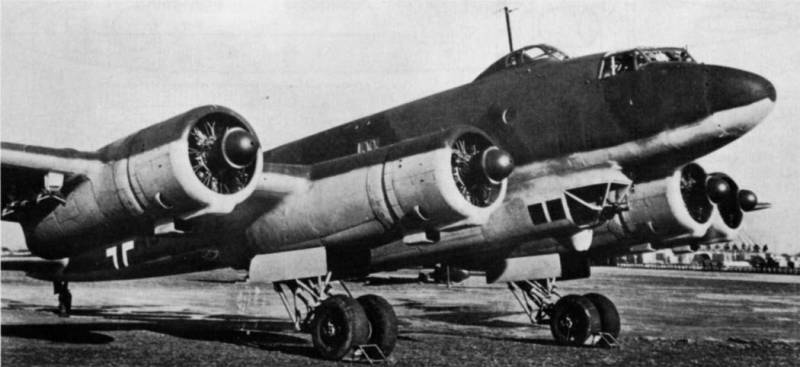
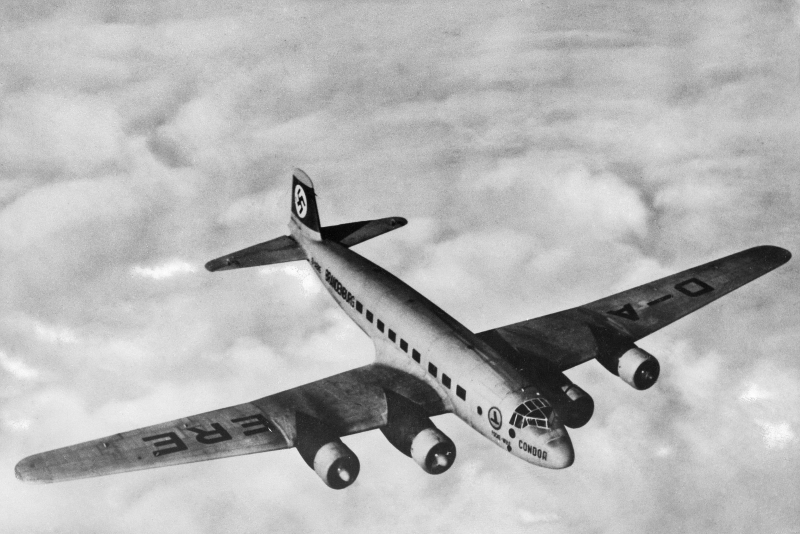
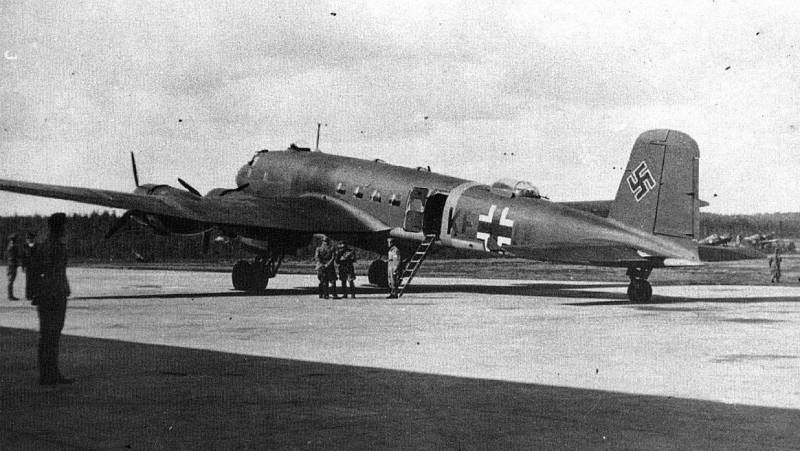
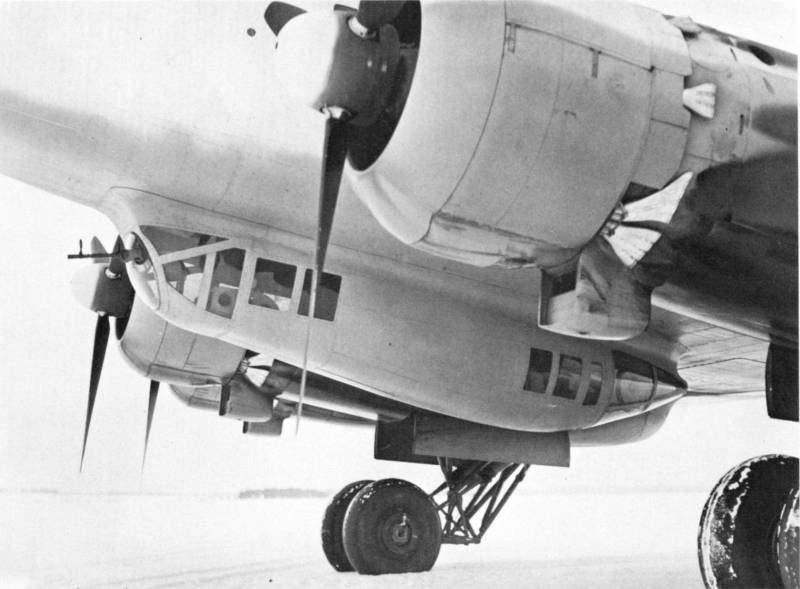
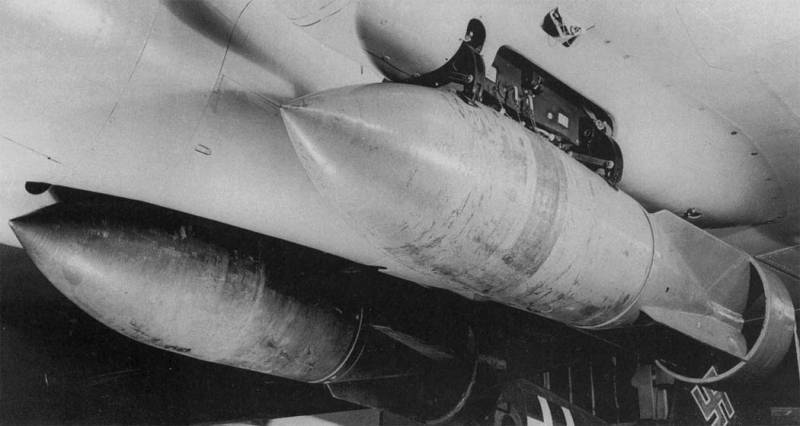
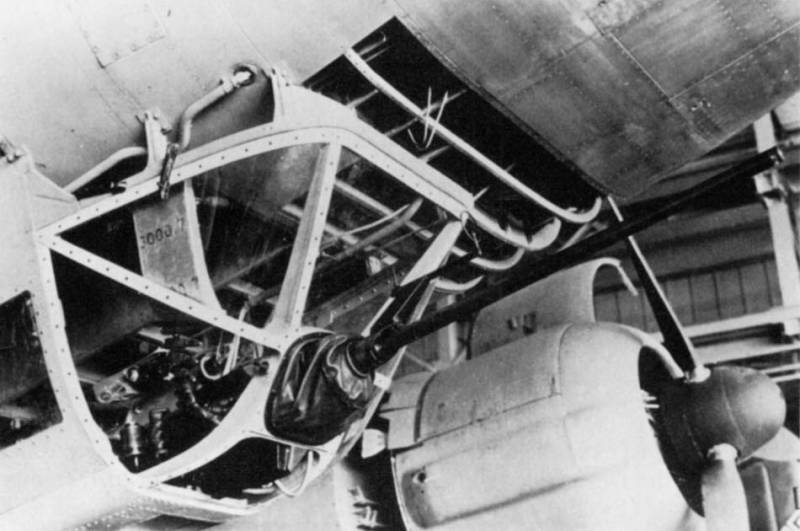
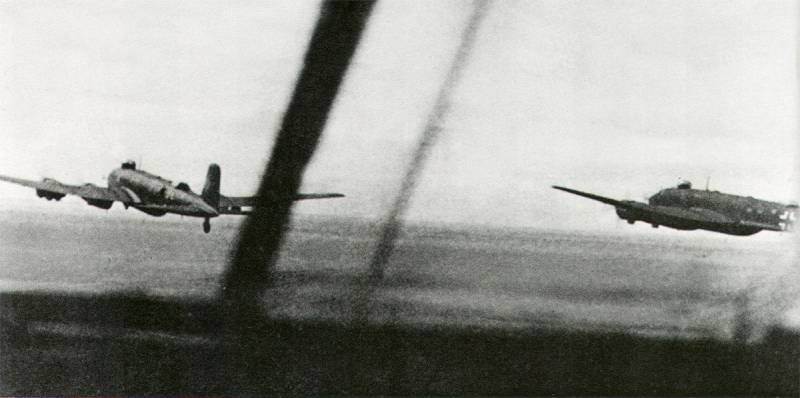
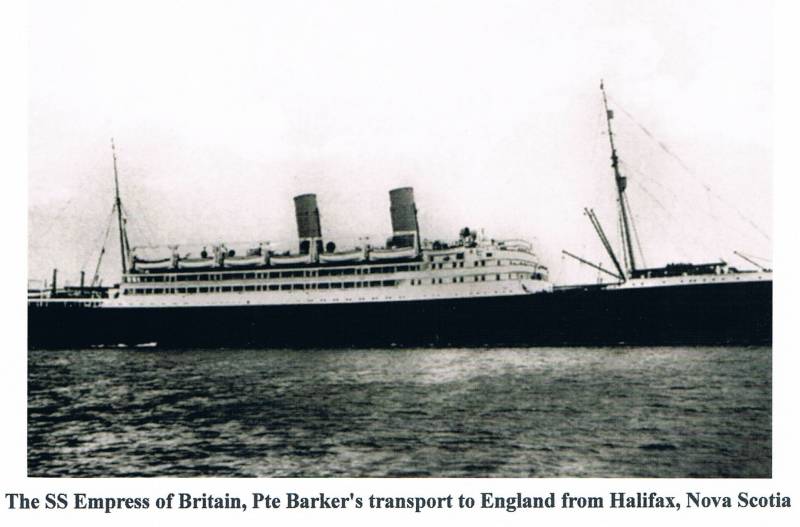
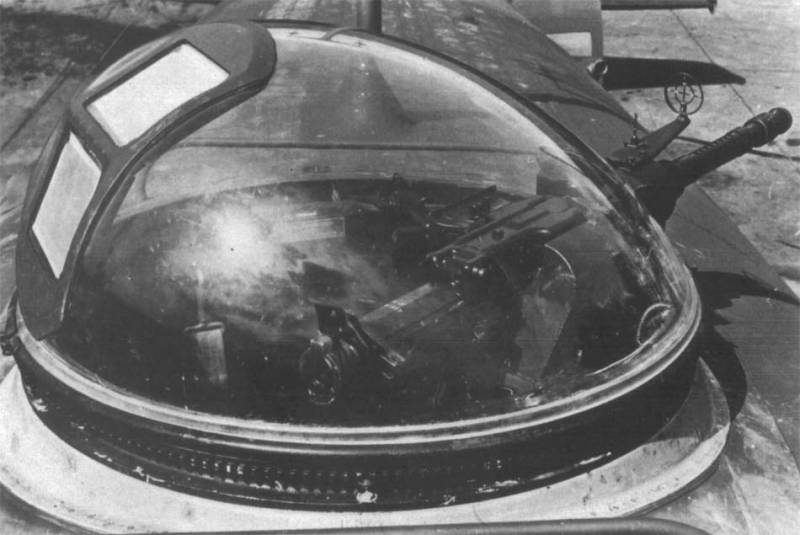
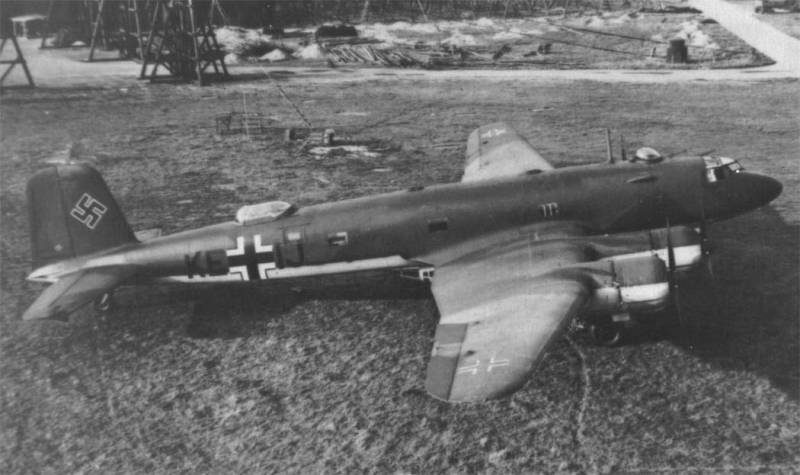
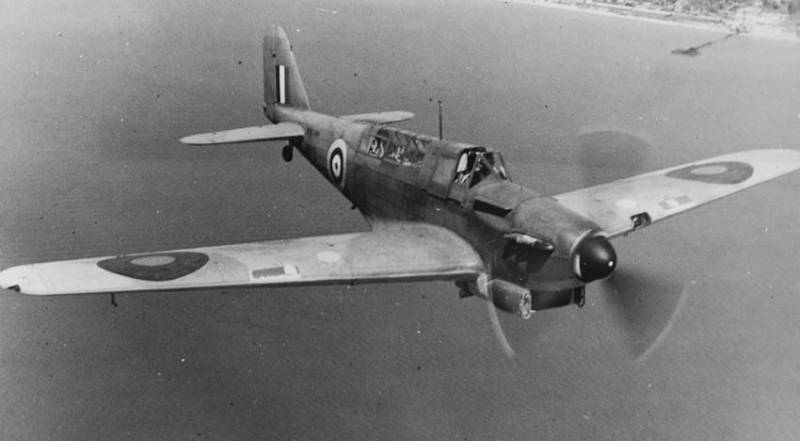
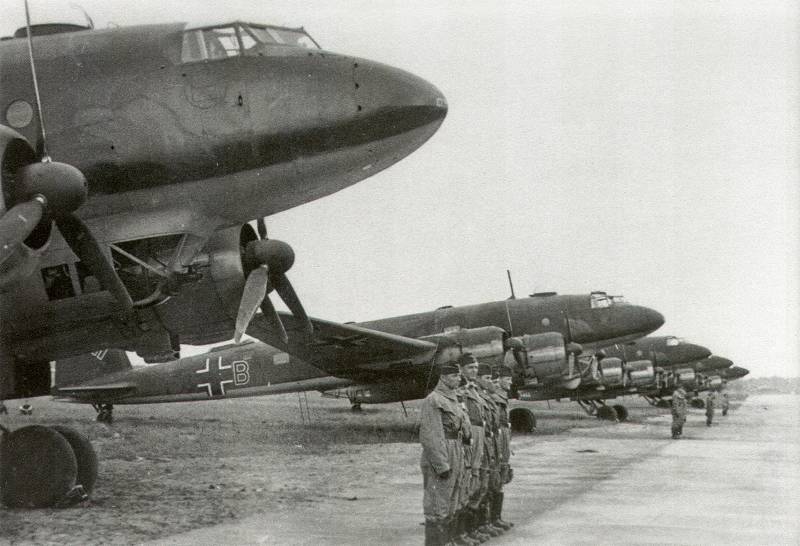
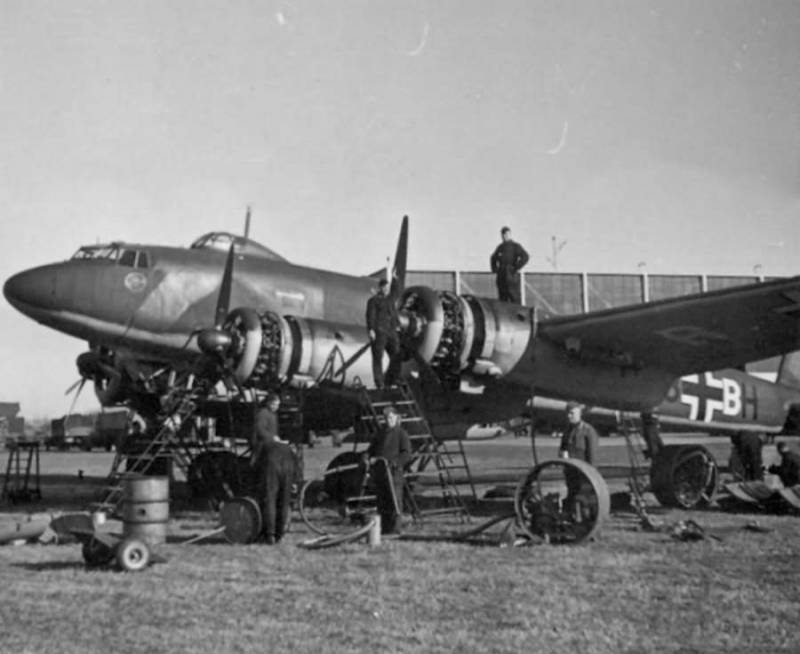
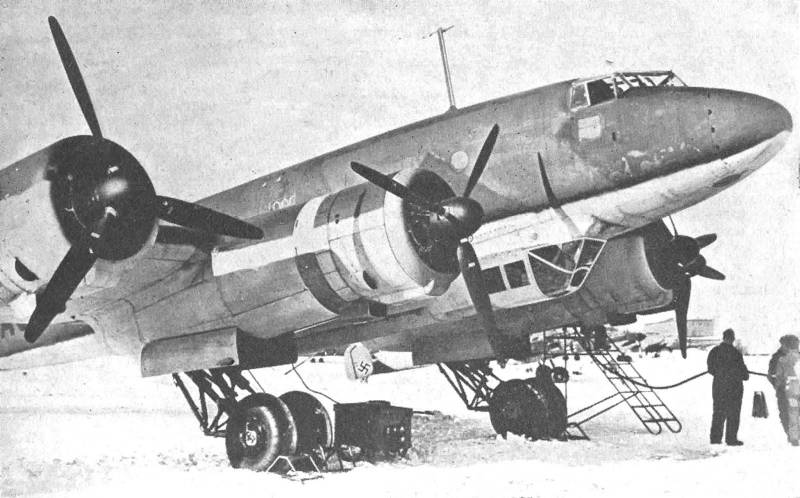
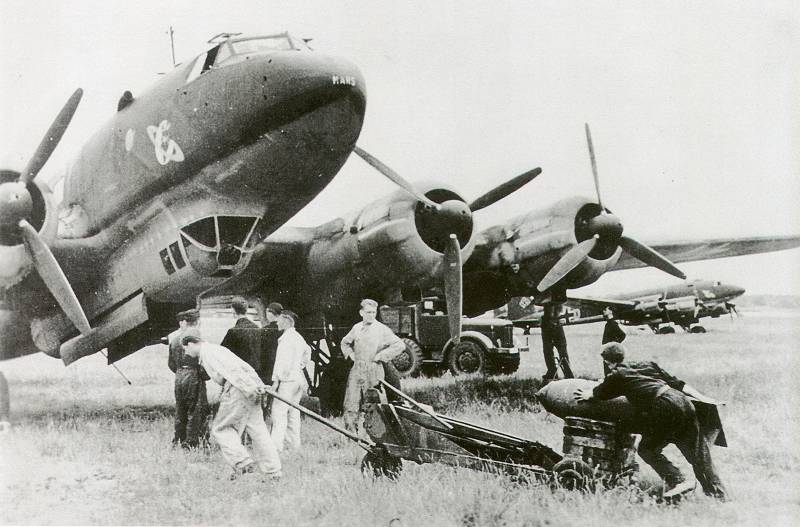
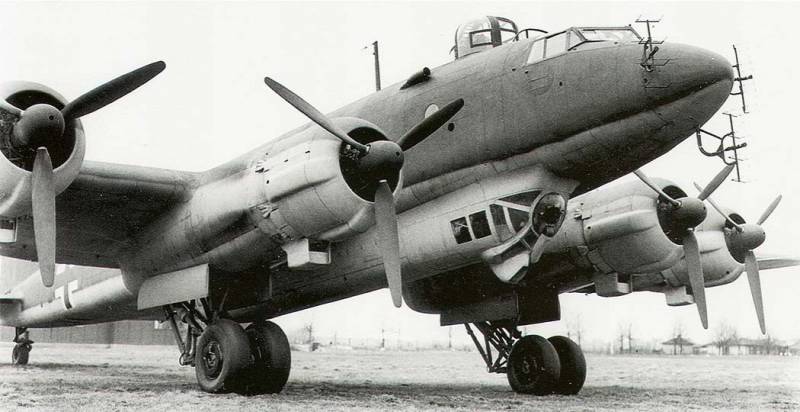
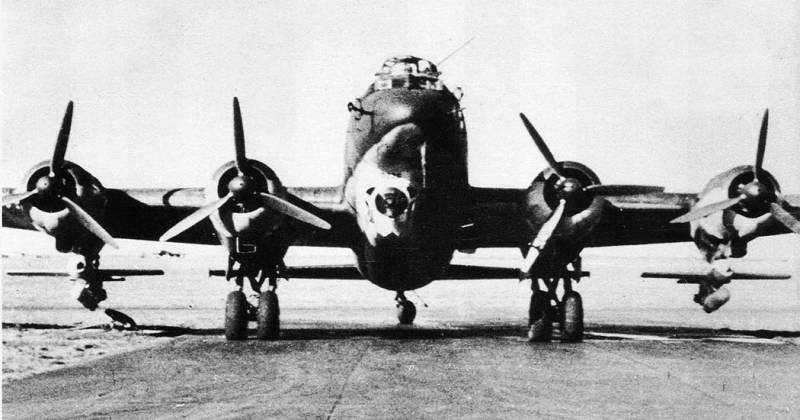
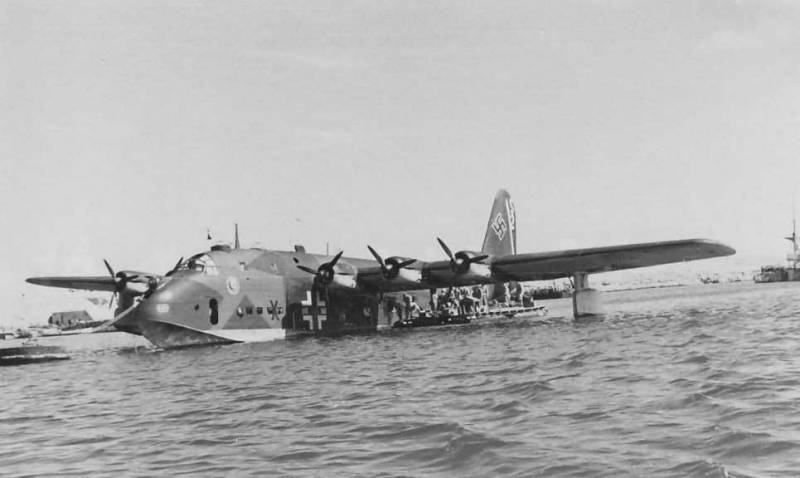
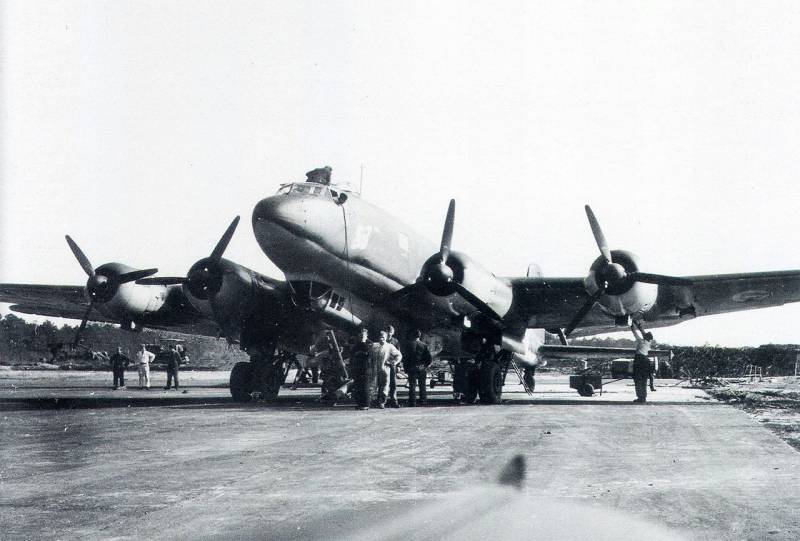
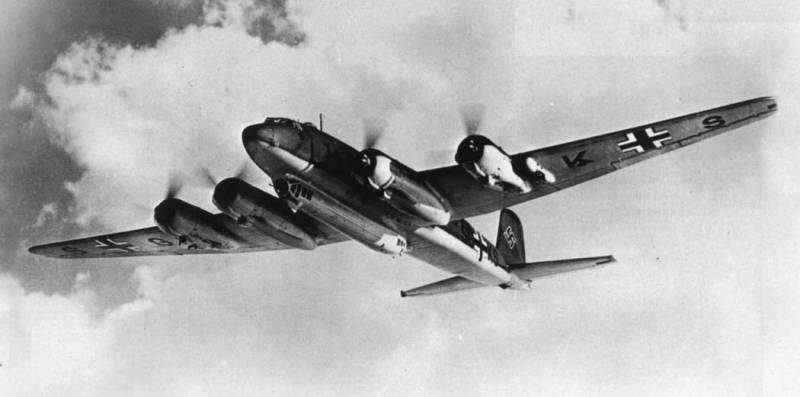
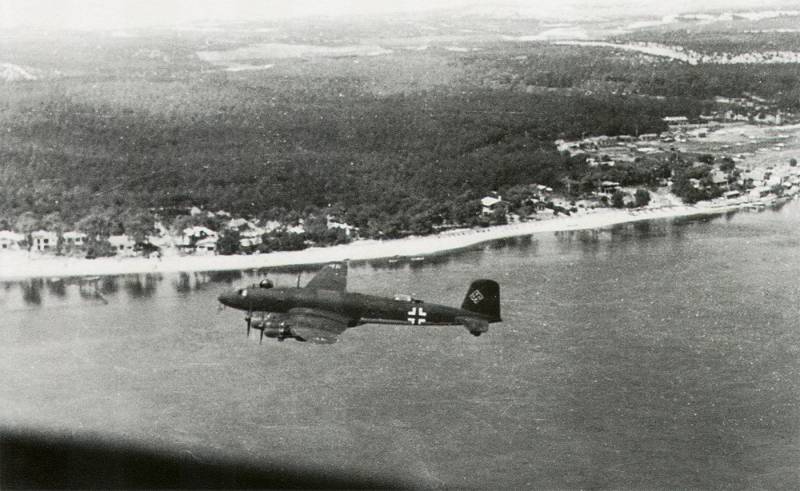
Information